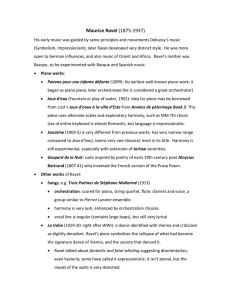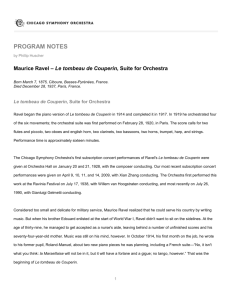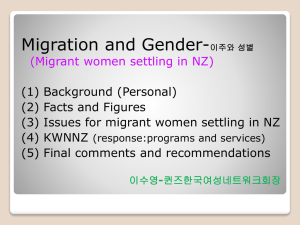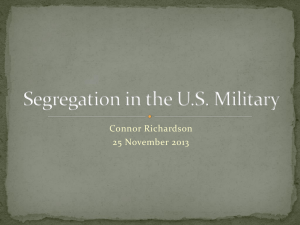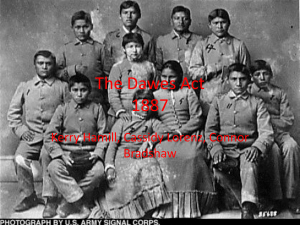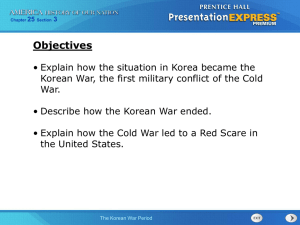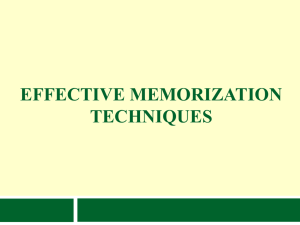Maurice Ravel and Korean Music
advertisement
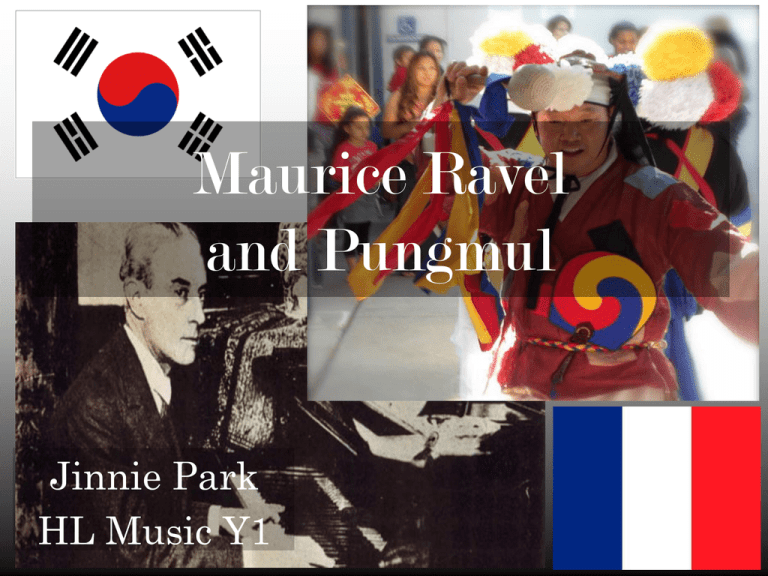
Maurice Ravel and Pungmul Jinnie Park HL Music Y1 Korea Population: 73 million (as of 2010) Principal Ethnicity: Korean Located on the Korean Peninsula, in North-East Asia Area: 219, 140 km² Religion: Traditionally Confucian and Buddhist, but 20th C Christianity in SOUTH Korea: -22.8% Buddhist -18.3% Protestant -10.9% Catholic -1.7% Other -46.5% No Religion South and West have plains; North and East are mountainous Many significant islands HISTORY • People began to live on the Korean Peninsula some 700,000 years ago • 5th C: Town-states evolved into tribal leagues - Three notable kingdoms developed • Starting in the 8thC, the Peninsula began to become more unified • Goryeo Dynasty (918-1392) - 1234: Invention of the world’s first movable type Joseon Dynasty (1392-1910) • Scientific and cultural advancement • Invention of the turtle ship, the world’s first iron-clad battleship • Switch from Buddhism to Confucianism • Invaded by Japanese, Manchuria, etc. • “Hermit Kingdom” - Isolationist principles to protect from Western imperialism • In 1897, became “The Korean Empire” Gyeongbok Palace Joseon Dynasty PUNGMUL • Korean folk tradition; originated in the Joseon Dynasty or before • Rooted in lower-class, farming culture • Involves singing, dancing, and drumming • Most performances take place outside • Constant motion Kkwaengawri Changgo Puk Nabal Jing Sogo 3:50 – 4:40; 7:38 – 8:14 http://www.youtube.com/watch?v=ztGeP1wCSiE&feature=related • Central part: drumming • Sometimes includes wind instruments (nabal, etc.) • Dancers, with elaborate, acrobatic choreography • Often play the sogo while dancing • Sometimes wear sangmo • Japsaek, actors, dressed as “caricatures of traditional village roles,” interact with the audience • Performers wear colorful costumes • Headgear: Buddhist kkokkal • May be a reflection of its shamanist influence BINARI http://www.youtube.com/watch?v=A3EvsdU8Hxg&feature=related 0:03 – 0:30 ● Originally a prayer song played at the beginning of a performer group’s stay at a village; meant to ask for blessings from village spirits ● Singing, dancing, and drumming ● Strong vocal and percussion ● Some repetition of rhythm ● ● Often played at samulnori performances Note: “Vocables” style of music notation that arranges written syllables (note representations) in tables Modern South Korea Pungmul Today ● Due to the large differences between Joseon Korean culture and modern culture, pungmul is not played as often as before – but efforts are being made to preserve the style. ● Important Intangible Cultural Property – 1962 Cultural Property Protection Law; after Japanese Occupation and Korean War Samulnori (1978 – ) ● University groups ● JOSEPH-MAURICE RAVEL • • • • • • French composer Known for his piano compositions, chamber music, vocal music, and orchestral music Was a leader of avant-garde French music Personality – “meticulous about his appearance, “ “well-read,” “sensitive and self-critical,” “mischievous sense of humor” attentive to form and craftsmanship Very original – not fully impressionistic or modernist Biography • • • • • • • Born March 7, 1875 in Ciboure, France Began piano lessons and theory lessons at age six – Was talented at the piano, but preferred composing Attended the Conservatoire de Paris – Was not successful academically, though he was considered “very gifted” in musical areas Was expelled in 1895 Returned to the Conservatoire in 1898, this time focusing on composing rather than on piano playing Studied composition with Gabriel Fauré until 1900 Studied each instrument’s unique abilities, color, and timbre • • • • • • • • • • Published a few early works, but was not well-accepted by critics Was considered “too radical” Met Debussy in the 1890s and became good friends By 1905, people were comparing the two and factions emerged, causing the men to grow distant During World War I, grew depressed over his mother’s death (1917) - Wasn’t allowed to be an aviator because of his short stature and weak health; became a truck driver instead After the War, began international tours – Was more popular overseas than in France Continued to gather popularity and wrote more pieces In 1932, he was in a car accident and began to exhibit signs of a neurological disease Consented to experimental brain surgery, but fell into a coma and never woke again Died on 28 December 1937 Influences ● Mother, Marie Delouart, was Basque, but grew up in Spain – ● Basque-Spanish folk songs sang to him at bedtime His father, Joseph Ravel, was Swiss; was interested in music and culture ● “As a child, I was sensitive to music – to every kind of music.” Brought him to visit factories; influenced rhythm of Boléro ● Nikolai Rimsky-Korsakov, at the Exposition Universelle (1889) ● ● ● Russian, foreign music Ricardo Viñes – pianist and one of his best friends ● Interpreted much of his piano music “Important link between Ravel and Spanish music” ● Café pianist Erik Satie ● “Distinctive personality and unorthodox musical experiments” ● André Gadalge - teacher ● ● ● Apaches (hooligans) – a group of composers, musicians, poets, etc. ● “artistic outcasts”; included Igor Stravinsky and Ricardo Viñes ● Met regularly until World War I Claude Debussy – different styles, but friends Major Works ● Jeux d'eau ● “first piano masterpiece,” “pathfinding impressionistic work” Mirrors (1905) ● Daphnes et Chloé (1909) ● Le tombeau de Couperin (1919) ● La Valse (1920) ● Boléro (1928) ● Boléro (1928) • Ballet, based on the musical form and Spanish dance, “bolero” • Written for a large orchestra • C major, ¾ time • Begins pianissimo and rises in a continuous crescendo • Key doubling and diatonic chords • REPETITION • Main continues to be played on C, minus eight measures of E major Ida Rubinstein Boléro (1928) http://www.youtube.com/watch?v=3-4J5j74VPw • • • • • Snare drum(s) play an unchanging ostinato rhythm constantly Two main melodies are repeated, passed from instrument to instrument – First is diatonic – Second has more syncopation and flats – Spanish-Arabic melody Pizzacato strings, mainly with tonic and dominant notes, accompany the themes LAST SIX BARS – Bass drum, cymbals, and tam-tam enter for the first time – Trombones and saxophones play “raucous glissandi” while the rest of the orchestra plays the snare drum’s rhythm – Dissonant D-flat chord to a C major chord Instruments either follow snare drum rhythm, the main theme, or a quarter/eighth note rhythm • Performance duration: 12 -18 minutes – Average time: 15 min. • Tempo di Bolero, moderato assai (very moderate) – Original metronome mark: ~66 – Modern editions usually play at 72 • Ravel preferred a steady tempo – like a metronome BINARI/PUNGMUL ● ● ● ● ● ● ● ● ● BOLÉRO Most performances are outside Number of performers differs “Farmer's music;” usually not for higher classes Was originally played at village events, shamanistic rituals.. Rural settings Blurred boundaries between audience and performers Vocal is important; no wind instruments Performers wear colorful costumes No conductor Improvisation is encouraged • • • • • • • • Usually played indoors Written for a large orchestra Rooted in Spanish dance Not often played in rural settings; concert halls Rhythm reminiscent of factories - ostinato Wind instruments play a large role Led by a conductor Rigid; Less improvisation SIMILARITIES • Preferred setting: outside ● Uses dancers in performance ● Was not predicted to be a success - Ravel once stated he wanted the performance to take place ● Style experienced change over time ● Performance varies depending on outside, against a factory performers backdrop. ● Represents a traditional style • Central element: drumming ● Repetition • Importance of rhythm ● Emphasis on dynamics • Has one central beat WORKS CITED "Instruments." Instruments. University of Chicago, n.d. Web. 15 Nov. 2012. <http://looseroots.uchicago.edu/instruments.html>. Kim, Hae Joo. "Pungmul Nori." Virtual Instrument Museum. Wesleyan University, 14 Nov. 2005. Web. 15 Nov. 2012. <http://www.wesleyan.edu/vim/cgi-bin/instrument.cgi?id=109>. "Korea at a Glance: History." Korea.net. KOCIS, n.d. Web. 15 Nov. 2012. <http://www.korea.net/AboutKorea/Korea-at-a-Glance/History>. "Overview of Pungmul and Samulnori." Cambridge Samulnori. Cambridge, n.d. Web. 23 Nov. 2012. <http://www.srcf.ucam.org/samulnori/samulnori%20overview%20.xhtml>. "Ravel: Concerto in D Major for Piano Left Hand and Orchestra." Broomlet. Broomlet, 22 Sept. 2008. Web. 15 Nov. 2012. <http://www.broomlet.com/archives/2008/09/ravel_concerto.html>. Roble, Neil. "Ravel's Greatest Hit - The Ultimate Bolero." Audioholics. N.p., 25 Feb. 2008. Web. 19 Nov. 2013. Sebastion. "Ravel's Bolero: A Mechanical Dance." Bolero. Favorite Classical Composers, 2010. Web. 15 Nov. 2012. <http://www.favorite-classical-composers.com/ravel-bolero.html>. Slipayamanant, Jon. "Korean Chongganbo and Far Eastern Music Notation Systems."Wordpress.com. N.p., 07 Nov. 2011. Web. 25 Nov. 2012. Stone, Stephen R. "A Waygukin's Guide to Samulnori." Wayguk Samulnori. Wetpaint, n.d. Web. 25 Nov. 2012. <http://wayguksamulnori.wetpaint.com/page/Sheet Music%3A %EC%95%85%EB%B3%B4>. "Traditional Musical Instruments of Korea." Sogang. Sogang University, 1998. Web. 15 Nov. 2012. <http://hompi.sogang.ac.kr/korean/kks100/lesson14/l14_03.html>. Yim, PJ. "Pungmul." PJYIM. Shinurl, n.d. Web. 25 Nov. 2012. <http://pungmul.pjyim.com/what-is-pungmul/5instruments>.
